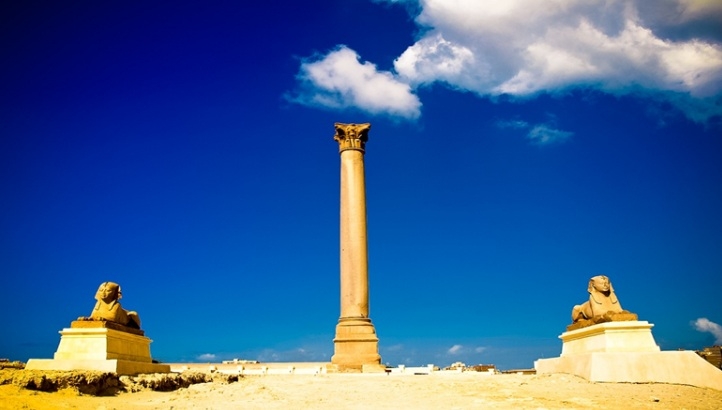The so-called "Pompey Pillar" is the biggest memorial column in Egypt. It is a huge column of red granite, its total height is about 28 m with a diameter at the base of 2.7 m, and towards the capital at the top it tapers to 2.3 m. It is located within the zone of the Serapeum of Alexandria and constructed in honor of the Emperor Diocletian as the Roman ruler of Egypt, during the reign of the Roman Emperor Diocletian, erected this memorial column between 284-305 A.D as a sign of gratitude. On the upper part of the base, are some Greek inscriptions which says :(To the most just Emperor, tutelary of Alexandria, Diocletian, the invincible Postumas, the perfect of Egypt, has erected this monument).
Its name is misleading and has nothing to do with the General Gaius Pompey who was Julius Caesar’s rival in a civil war and was murdered by a Ptolemaic pharaoh in 48 BC when he fled to Alexandria. The Crusaders believed, mistakenly, that the ashes, or the remains, of the great Roman general Pompey were in a pot at the top of the column. Thus today it is called "Pompey's Pillar".
The site contains galleries where sacred Apis bulls were buried, and three sphinxes, the column must have been erected after 292 A.D. Around the commemorative Column of Diocletian there are some monuments that can be seen. On the backside, there are the remains of a Serapium, or a temple of the God Serapis, now badly damaged. It was built during the reigns of Ptolemy II and Ptolemy III, but was damaged due to the revolts of the Jewish population in Alexandria. It was rebuilt again during the reign of the Emperor Trajan (89-118 A.D), but It was likely was destroyed after the appearance of Christianity. It consisted mainly of a high platform accessed by a staircase of 100 steps.
Today the only single column marks the site which was once a huge and elaborate temple, some of the tunnels around the complex remain and are open for tourists to explore and some of the artifacts from the temple have been recovered. A life-size black basalt bull from the temple and a golden plaque marking the foundation of the Serapis are on display in the Greco-Roman Museum.

